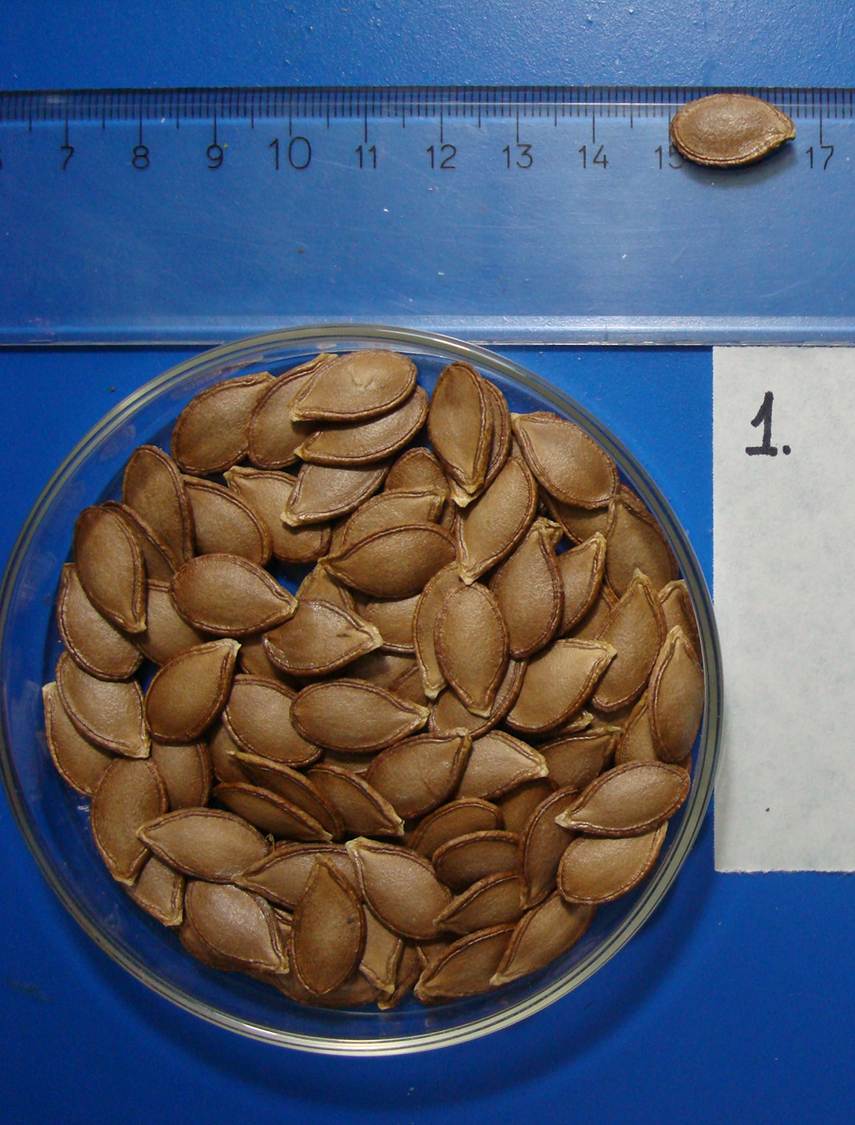Selecting squash (Cucurbita sp.) introductions by seed nutritional quality and seed meal

Abstract
Squash (Cucurbita sp.) is widely used in Colombia as both food and animal feed. However, its seeds are discarded. This study aimed to identify squash genotypes with a high nutritional value in the whole seed meal (WSM) and defatted seed meal (DSM) within a group of 19 introductions (14 of Cucurbita moschata and 5 of C. sororia). For WSM, 70% of the introductions presented above-average values for extract (36.9%) and crude protein (26.34%); the fiber values were 20.34% neutral detergent fiber (NDF) and 13% acid detergent fiber (ADF). For DSM, 57% of the introductions presented above-average crude protein (43.5%) and 52% above-average crude energy values (4078 cal g-1). Based on the relative feed value (RFV), introductions 1229, 1200, 1201, 1219 and 1206 were selected for WSM, and 1206 1229, 932, 1200, 786 and 954 were selected for DSM. In the selected C. moschata introductions, parents with general and specific combining abilities for ether extract and crude protein in WSM or high RFV in DSM should be identified. C. soraria introductions 1202 and 954 should be used in crosses that aim to obtain F2 segregants for seeds with a high oil content and high RFV in DSM.
Keywords
Cucurbita moschata, Cucurbita sororia, Defatted seed meal, Squash seeds, Whole seed meal, High forage value
References
Arija, L., A. Viveros, A. Brenes, and R. Canales. 1999. Estudio del valor nutricional de la semilla de girasol entera descascarillada en raciones de pollos broiler y su efecto sobre la concentración de ácidos grasos en la grasa abdominal. Arch. Zootec. 48(183), 249-259.
Chatterjee, A. and T.K. Walli. 2002. Comparative evaluation of protein quality of three commonly available oilseed cakes by in vitro and in sacco method. Indian J. Dairy Sci. 55(6), 350-355.
Cook, B.G., B.C. Pengelly, S.D. Brown, J.L. Donnelly, D.A. Eagles, M.A. Franco, J. Hanson, B.F. Mullen, I.J. Partridge, M. PETER, and R. Schultze-Kraft. 2005. Tropical Forages: an interactive selection tool [CD-ROM], CSIRO, DPI&F(Qld), CIAT and ILRI, Brisbane, Australia.
Hidalgo, H.R. and C.F.A. Vallejo. 2014. Bases para el estudio de recursos genéticos de especies cultivadas. Universidad Nacional de Colombia, Palmira, Colombia.
Hoffman, P. and D. Combs. 2014. Using NDF digestibility in ration formulation, UW-Madison Dairy Science Department Marshfield Agricultural Research. Focus on Forage 6(3), 1-4.
Holguín, V.A., G.S. Ortiz, N.A. Velasco, and D.J. Mora. 2015. Evaluación multicriterio de 44 introducciones de Tithonia diversifolia (hemsl.) A. Gray en Candelaria, Valle del Cauca. Rev. Med. Vet. Zoot. 62(2):57-72. Doi: http://dx.doi.org/10.15446/rfmvz
Mcsweeney, C. and R. Mackie. 2012. Micro-organisms and ruminant digestion: state of knowledge, trends and future prospects. In: http://www.fao.org/docrep/016/me992e/me992e.pdf; consulted: February, 2019.
Mcilroy, R.J. 1973. Introducción al cultivo de los pastos tropicales, Limusa, México DF.
Nikkhah, A. 2015. Multisource starch for optimal rumen and ruminant integrity. J. Adv. Dairy Res. 3, 4. Doi: 10.4172/2329-888X.1000e130
Olabisi, A.D. 2015. Degradation kinetics of carbohydrate fraction of commercial concentrate feeds for weaned calves, heifers, lactating and dry dairy cattle. MSc thesis. University of South Africa, Pretoria, South Africa.
Ortiz, G.S., L.S. Pasos, A.X. Rivas, R.M.P. Valdés, and C.F.A. Vallejo. 2009. Extracción y caracterización de aceite de semillas de zapallo. Acta Agron. 58, 145-151.
Ortiz, G.S., C.F.A. Vallejo, G.D. Baena, S.E.I. Estrada, and R.M.P. Valdés. 2013. Zapallo para consumo en fresco y fines agroindustriales: investigación y desarrollo. Feriva, Cali, Colombia.
Pascual, CH.G., M.S. Molina, S.C. Morales, G.K. Valdivia, and J.F. Quispe. 2006. Extracción y caracterización de aceite de diez entradas de semilla de maní (Arachis hypogaea L.) y elaboración de maní bañado con chocolate. Mosaico Cient. 3(1), 2213-2216.
Pereira, V.T.N., E. Detmann, and S.C. Batista. 2015. Recent advances in evaluation of bags made from different textiles used in situ ruminal degradation. Can. J. Anim. Sci. 95, 493-498. 10.1139/cjas-2017-0064
Ramírez, B.L., P. Lavelle, J.A. Orjuela, and O. Villanueva. 2012. Caracterización de fincas ganaderas y adopción de sistemas agroforestales como propuesta de manejo de suelos en Caquetá, Colombia. Rev. Col. Cienc. Pecu. 25, 391-401.
Rodríguez C.R.M., Suárez H.J. and Támbara H.Y. 2016. Caracterización de la torta obtenida del prensado del fruto de Jatropha curcas. Pastos Forrajes 39(1), 72-75.
Rodríguez, R.R.A., R.M.P. Valdés, and G.S. Ortiz. 2018. Características agronómicas y calidad nutricional de los frutos y semillas de zapallo Cucurbita sp. Rev. Colomb. Cienc. Anim. Recia 10(1), 86-97. Doi: https://doi.org/10.24188/recia.v10.n1.2018.636
Roy, D. 2000. Plant breeding analysis and exploitation of variation, Alpha Science International, Pangbourne, UK. In: https://www.amazon.com/Plant-Breeding-Analysis-Exploitation-Variation/dp/1842650068; consulted: March, 2018.
Sánchez, V., G. Delreal, C. Plazas, and G. Pérez. 2015. Factibilidad económica de la asociación maíz-pasto en el establecimiento de un sistema silvopastoril en el piedemonte llanero de Colombia. Pastos Forrajes 38(1), 73-79.
SAS. 2013. User’s guide: statistics. Statistical Analysis System versión 9.4. SAS Institute Inc., Cary, NC.
Valdés, R.M.P., G.S. Ortiz, and C.F.A. 2014. Efectos heteróticos para el carácter extracto etéreo en la semilla de zapallo Cucurbita moschata Duch. Rev. U.D.C.A Act. & Div. Cient. 17(2), 371-379.
Valdés, R.M.P., G.S. Ortiz, G.D. Baena, and C.F.A. Vallejo. 2010. Evaluación de poblaciones de zapallo (Cucurbita moschata) por caracteres de importancia agroindustrial. Acta Agron. 29(1), 91-96.
Younis, Y.M., S. Ghirmay, and S.S. Al-Shihry. 2000. African Cucurbita pepo L.: properties of seed and variability in fatty acid composition of seed oil. Phytochemistry 54, 71-75. 10.1016/j.phytochem.2018.01.007
